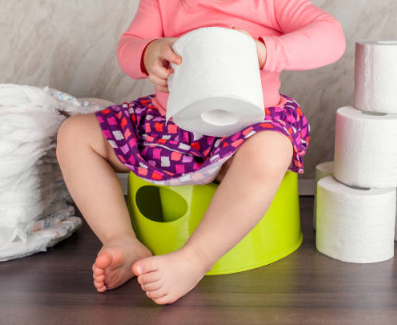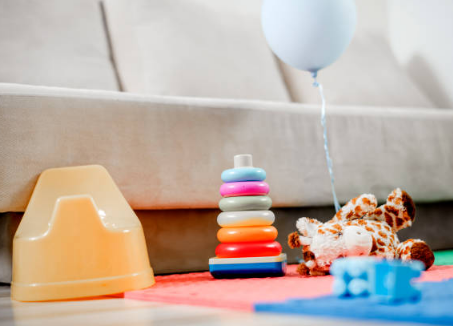Are you ready to start potty training? You may want to consider using a potty training chart, which is a useful tool that can help you and your child streamline the process and reduce stress. Read on to learn about the benefits of potty training charts and how to use them effectively, and download our lovely printable charts.
What Is a Potty Training Chart?
Incentives can be helpful if your child is ready to start potty training, or if they have already started but you find it difficult to motivate them. One incentive that many parents find effective for potty training is the use of potty training charts as a reward system.
Potty training charts help track your child’s progress and patterns during potty training. Whenever your child is successfully using the potty or taking a big step in using the potty, you can add stickers or gold stars to the chart to give some encouragement and recognition to the achievements of your potty training star.

Tip
It’s important to note that potty training doesn’t usually happen immediately or over a predictable time, so being patient, flexible, and positive along the way is the best approach. As always, your child will appreciate your encouragement and support without feeling stressed.
Benefits of Using Potty Training Charts
Your encouragement, support, and patience may be all you need to get your child to potty training smoothly. But once in a while, you might consider helping solve the problem with gentle and fun incentives, such as potty training sheets. Here are some of the benefits of using a potty training table:
- Provides positive reinforcement. Positive rewards and praise for good behavior may cause your child to repeat the behavior. If your child associates the potty with something positive, such as receiving another sticker on a potty training sheet, they may choose to use the potty.
- Improves self-esteem. Positive reinforcement for good behavior and accomplishments can help improve a child’s self-esteem. They may be more aware that they have done something good and can be proud of what they have accomplished, especially if they can visually see their progress on a chart.
- Track success. This will help you and your child. Charts can help you track their progress and notice any patterns in their potty training behavior, such as how long they are successfully using the potty during the day. Plus, your kids can see all of their great work prominently displayed! You can also use this information when updating your child’s healthcare provider.
- Instant rewards are available. Receiving a sticker or gold star on the chart immediately after using the potty may help your child better associate behaviour with reward. A sticker or star may seem like just a small reward, but it can be an exciting and enticing prize for your child. Keeping it small also helps to focus on mastering the art of using the potty rather than prizes and gifts.
How to Use the Potty Training Chart
The best thing about the toilet training chart is that you can customize it to your liking or your child’s age. For example, you can put a sticker on your child every time they successfully use the potty, or a sticker after a “dry day”. Some parents may choose to put a sticker on each of their child’s little successes, such as asking for the potty to be used, to sit on the potty, or to wash their hands.
For many kids, simply putting a sticker or gold star on their potty training sheet is enough of a reward! Some parents may decide to give small prizes after reaching a certain number of stickers or accident-free days. Maybe you can change your goals for older children, or as potty training progresses, like making an effort to wear “older kid” pants.
How to Introduce Your Child to Potty Training Sheets
Here are some tips for introducing potty training charts to your child:
- Customize your potty training charts or stickers based on your child’s interests (e.g., dinosaurs, fairy tales, cars, etc.). This will make them even more excited!
- Introduce your child to the diagram and explain how it works.
- Hang the chart in a prominent place and at eye level with your child. This will serve as a reminder for them to see their progress.
- You may also want to encourage and remind them to use the potty throughout the day and identify toilet tips, or you may even find it helpful to develop a potty Xi.
- Reinforce and align with the way you use potty training charts. Having your child add stickers to their charts themselves may increase the excitement and better reinforce the connection between using the potty and getting rewarded.

Potty Training Rewards Creativity
As mentioned above, sometimes potty training charts and stickers are enough for your child, and the excitement they get when they see potty training charts fill up in a week may be all they need encouragement. However, if your child needs extra motivation, if they reach the goals you set, here are some potty training reward ideas you might consider:
- Non-material rewards can include a compliment from you or another family member or a big hug. When your child reaches the goal, you may even find it fun to perform some celebratory songs or dances. Try not to overdo it or make it too big, as this can put too much stress on the child.
- When your child reaches their potty training goals, give them small inexpensive rewards such as stickers, crayons, or small collectible toys.
- Books are a fun and educational reward for children, especially if you find some cute books about potty training to encourage them further.
- Older children’s underwear can be a fun incentive for your little one and the ultimate goal for them to learn how to use the potty. You may even want to wear training pants while potty training.
Of course, potty training rewards are optional, but if you decide to offer them, it’s usually best to avoid the big and expensive ones. The focus is on giving your child confidence and learning Xi potty rather than getting a new toy. Experts also advise against using food as a reward.
The Bottom Line
We hope that the information provided in this article will help you and your child achieve potty training success! If your child has mastered daytime potty training, it may be time to start nighttime potty training.
Keep in mind that it’s important to be patient and consistent in this process, as every child learns Xi differently. If you need more help with potty training, you can try the 3-day potty training method or learn more about potty training regression if your child has some setbacks. As always, celebrate small successes and don’t forget to have fun!

